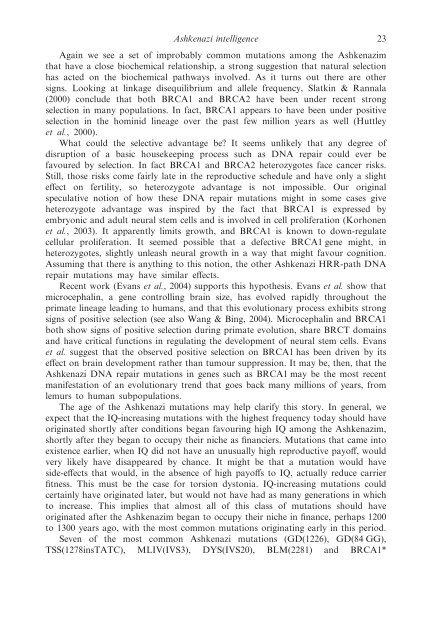natural history of ashkenazi intelligence - Henry C Harpending ...
natural history of ashkenazi intelligence - Henry C Harpending ...
natural history of ashkenazi intelligence - Henry C Harpending ...
Create successful ePaper yourself
Turn your PDF publications into a flip-book with our unique Google optimized e-Paper software.
Ashkenazi <strong>intelligence</strong> 23<br />
Again we see a set <strong>of</strong> improbably common mutations among the Ashkenazim<br />
that have a close biochemical relationship, a strong suggestion that <strong>natural</strong> selection<br />
has acted on the biochemical pathways involved. As it turns out there are other<br />
signs. Looking at linkage disequilibrium and allele frequency, Slatkin & Rannala<br />
(2000) conclude that both BRCA1 and BRCA2 have been under recent strong<br />
selection in many populations. In fact, BRCA1 appears to have been under positive<br />
selection in the hominid lineage over the past few million years as well (Huttley<br />
et al., 2000).<br />
What could the selective advantage be? It seems unlikely that any degree <strong>of</strong><br />
disruption <strong>of</strong> a basic housekeeping process such as DNA repair could ever be<br />
favoured by selection. In fact BRCA1 and BRCA2 heterozygotes face cancer risks.<br />
Still, those risks come fairly late in the reproductive schedule and have only a slight<br />
effect on fertility, so heterozygote advantage is not impossible. Our original<br />
speculative notion <strong>of</strong> how these DNA repair mutations might in some cases give<br />
heterozygote advantage was inspired by the fact that BRCA1 is expressed by<br />
embryonic and adult neural stem cells and is involved in cell proliferation (Korhonen<br />
et al., 2003). It apparently limits growth, and BRCA1 is known to down-regulate<br />
cellular proliferation. It seemed possible that a defective BRCA1 gene might, in<br />
heterozygotes, slightly unleash neural growth in a way that might favour cognition.<br />
Assuming that there is anything to this notion, the other Ashkenazi HRR-path DNA<br />
repair mutations may have similar effects.<br />
Recent work (Evans et al., 2004) supports this hypothesis. Evans et al. show that<br />
microcephalin, a gene controlling brain size, has evolved rapidly throughout the<br />
primate lineage leading to humans, and that this evolutionary process exhibits strong<br />
signs <strong>of</strong> positive selection (see also Wang & Bing, 2004). Microcephalin and BRCA1<br />
both show signs <strong>of</strong> positive selection during primate evolution, share BRCT domains<br />
and have critical functions in regulating the development <strong>of</strong> neural stem cells. Evans<br />
et al. suggest that the observed positive selection on BRCA1 has been driven by its<br />
effect on brain development rather than tumour suppression. It may be, then, that the<br />
Ashkenazi DNA repair mutations in genes such as BRCA1 may be the most recent<br />
manifestation <strong>of</strong> an evolutionary trend that goes back many millions <strong>of</strong> years, from<br />
lemurs to human subpopulations.<br />
The age <strong>of</strong> the Ashkenazi mutations may help clarify this story. In general, we<br />
expect that the IQ-increasing mutations with the highest frequency today should have<br />
originated shortly after conditions began favouring high IQ among the Ashkenazim,<br />
shortly after they began to occupy their niche as financiers. Mutations that came into<br />
existence earlier, when IQ did not have an unusually high reproductive pay<strong>of</strong>f, would<br />
very likely have disappeared by chance. It might be that a mutation would have<br />
side-effects that would, in the absence <strong>of</strong> high pay<strong>of</strong>fs to IQ, actually reduce carrier<br />
fitness. This must be the case for torsion dystonia. IQ-increasing mutations could<br />
certainly have originated later, but would not have had as many generations in which<br />
to increase. This implies that almost all <strong>of</strong> this class <strong>of</strong> mutations should have<br />
originated after the Ashkenazim began to occupy their niche in finance, perhaps 1200<br />
to 1300 years ago, with the most common mutations originating early in this period.<br />
Seven <strong>of</strong> the most common Ashkenazi mutations (GD(1226), GD(84 GG),<br />
TSS(1278insTATC), MLIV(IVS3), DYS(IVS20), BLM(2281) and BRCA1*


